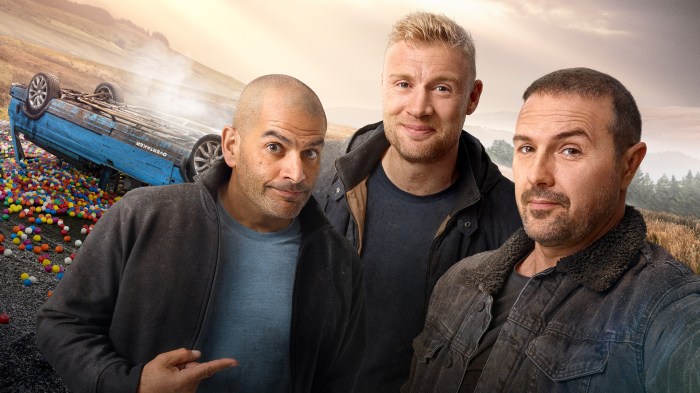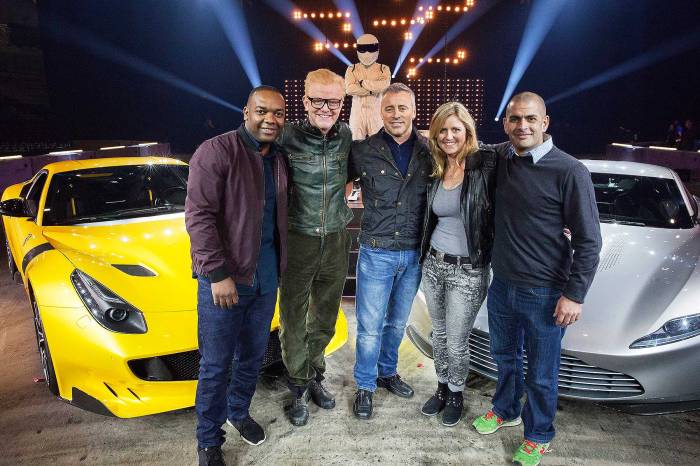Top Gear, the automotive show that has captured the hearts and minds of car enthusiasts worldwide, is a phenomenon that has left an indelible mark on popular culture. From its humble beginnings to its current status as a global sensation, Top Gear has evolved into a cultural icon that transcends the boundaries of automotive entertainment.
Through its unique blend of humor, adventure, and car reviews, Top Gear has not only entertained audiences but also shaped the way we perceive cars and the automotive industry. Join us as we delve into the fascinating world of Top Gear, exploring its historical evolution, content analysis, cultural impact, and comparisons to other automotive shows.
Historical Evolution of Top Gear
Top Gear, the world-renowned automotive television series, has undergone a remarkable journey since its inception in 1977. Over the decades, it has evolved from a humble consumer affairs program to a global phenomenon, captivating audiences with its unique blend of car reviews, challenges, and humor.
Format Changes
- 1977-2001:Originally titled “Top Gear,” the show focused on practical car reviews and consumer advice.
- 2002-2015:The show underwent a significant transformation under the stewardship of Jeremy Clarkson, Richard Hammond, and James May. This era is characterized by its high-octane stunts, celebrity guests, and irreverent humor.
- 2016-2019:Following the departure of Clarkson, Hammond, and May, the show continued with new hosts Chris Evans and Matt LeBlanc. However, this period was marked by declining ratings and criticism.
- 2019-Present:Top Gear returned with a refreshed format, hosted by Paddy McGuinness, Freddie Flintoff, and Chris Harris. The show has regained some of its former glory, focusing on car reviews, challenges, and travelogues.
Milestones
- 1988:The show was relaunched with a new focus on road tests and automotive news.
- 1994:Jeremy Clarkson joined as a presenter, marking the beginning of the show’s golden age.
- 2002:The show’s format was overhauled, introducing the “Star in a Reasonably Priced Car” segment.
- 2006:Top Gear became the world’s most-watched factual television program.
- 2015:Clarkson, Hammond, and May left the show after a controversy involving Clarkson.
Hosts, Top Gear
- Jeremy Clarkson:Known for his outspoken opinions and irreverent humor, Clarkson was the face of Top Gear for 13 seasons.
- Richard Hammond:Hammond’s infectious enthusiasm and penchant for mishaps brought a unique charm to the show.
- James May:May’s dry wit and encyclopedic knowledge of cars made him an invaluable member of the trio.
- Chris Evans:Evans’s tenure as host was short-lived and met with mixed reviews.
- Matt LeBlanc:The American actor and comedian brought a fresh perspective to the show.
- Paddy McGuinness:McGuinness, known for his comedic talents, has helped revitalize the show.
- Freddie Flintoff:The former cricketer and television personality adds a competitive edge to the show’s challenges.
- Chris Harris:Harris, a respected automotive journalist, provides expert insights and car reviews.
Content Analysis of Top Gear Episodes
Top Gear episodes adhere to a consistent structure and format, featuring a range of recurring segments, challenges, and guest appearances. These elements contribute to the show’s appeal and target a diverse audience.
Typical Structure and Format
Episodes typically begin with an introduction featuring the show’s hosts, who present an overview of the episode’s content. This is followed by a series of segments, including car reviews, challenges, and guest interviews. The episode concludes with a “news” segment, where the hosts discuss automotive-related headlines and events.
Recurring Segments
Top Gear episodes feature several recurring segments, including:
- Star in a Reasonably Priced Car:A celebrity guest drives a designated car around a test track, with their lap time compared to those of previous guests.
- Power Laps:The hosts attempt to set the fastest lap time on a race track in a particular car.
- Challenges:The hosts engage in various challenges involving cars, such as races, stunts, or endurance tests.
Guest Appearances
Top Gear often features guest appearances from celebrities, racing drivers, and automotive experts. These guests provide insights, participate in challenges, and share their experiences with cars.
Top Gear, the British motoring show, has been captivating audiences for over two decades. The show’s irreverent humor, engaging hosts, and stunning cinematography have made it a global phenomenon. If you’re a car enthusiast or simply enjoy a good laugh, check out Top Gear for an unforgettable automotive experience.
Appeal and Target Audience
Top Gear’s appeal lies in its combination of humor, automotive knowledge, and adrenaline-pumping challenges. The show’s target audience includes car enthusiasts, gearheads, and anyone interested in the world of automobiles. Top Gear’s accessible and entertaining format makes it enjoyable for viewers with varying levels of automotive knowledge.
Cultural Impact of Top Gear

Top Gear’s global reach and popularity have left an indelible mark on popular culture. It has not only shaped the perception of car enthusiasts but also influenced automotive trends and promoted tourism worldwide.
Top Gear, a British motoring show, has gained immense popularity worldwide for its unique blend of automotive enthusiasm, humor, and adventure. The show’s charismatic hosts, namely Jeremy Clarkson, Richard Hammond, and James May, have become synonymous with the Top Gear brand, captivating audiences with their witty banter and exhilarating driving stunts.
Top Gear has undoubtedly revolutionized the way we perceive and enjoy motoring shows, leaving an indelible mark on the automotive entertainment landscape.
Automotive Trends and Car Enthusiast Culture
Top Gear has played a pivotal role in shaping automotive trends. Its unique blend of humor, entertainment, and car reviews has made it a go-to source for car enthusiasts worldwide. The show’s hosts have become influential figures in the automotive industry, and their opinions and recommendations carry significant weight.
- The show’s focus on performance and off-road driving has popularized these driving styles and encouraged car manufacturers to develop vehicles that cater to these demands.
- Top Gear’s emphasis on practicality and value for money has made it a trusted source for consumers seeking advice on car purchases.
- The show’s light-hearted approach to car culture has helped break down stereotypes and make car enthusiasm more accessible to a wider audience.
Tourism and Global Automotive Scenes
Top Gear’s global reach has made it an effective platform for promoting tourism. The show’s episodes often feature stunning locations around the world, showcasing local automotive scenes and inspiring viewers to explore new destinations.
- The show’s coverage of exotic car markets, such as Dubai and India, has introduced viewers to different automotive cultures and broadened their understanding of the global car scene.
- Top Gear’s challenges and races in various countries have highlighted local driving conditions and automotive traditions, fostering cultural exchange and appreciation.
- The show’s production values and stunning visuals have made it a powerful promotional tool for tourism boards, showcasing the beauty and diversity of different regions.
Comparisons to Other Automotive Shows
Top Gear stands out from other automotive shows due to its unique format, content, and target audience. In comparison to The Grand Tour, Top Gear is more lighthearted and comedic, with a focus on entertainment rather than technical details. The Grand Tour, on the other hand, is more serious and analytical, delving into the technical aspects of cars and featuring longer, more in-depth reviews.
Compared to MotorWeek, Top Gear is more personality-driven, relying on the chemistry between its hosts to entertain viewers. MotorWeek, in contrast, is more informative and straightforward, providing detailed reviews and road tests without the same level of comedic banter.
Target Audience
Top Gear’s target audience is broader than that of The Grand Tour or MotorWeek. Top Gear appeals to a general audience interested in cars and entertainment, while The Grand Tour targets enthusiasts seeking a more technical and in-depth experience. MotorWeek, on the other hand, caters primarily to car enthusiasts seeking comprehensive and unbiased reviews.
Future of Top Gear

As the automotive landscape continues to evolve, the future of Top Gear remains uncertain. With the rise of electric vehicles and autonomous driving, the show may need to adapt its format and content to stay relevant.
One potential change could be a shift towards more in-depth technical analysis of vehicles. As cars become increasingly complex, viewers may be interested in learning more about the technology behind them. Top Gear could also focus on the environmental impact of cars, as this becomes an increasingly important issue for consumers.
The popular automotive show “Top Gear” has captivated audiences worldwide with its thrilling car reviews, hilarious challenges, and quirky presenters. From the original trio of Jeremy Clarkson, Richard Hammond, and James May to the current lineup featuring Chris Harris, Paddy McGuinness, and Freddie Flintoff, Top Gear continues to deliver a unique and entertaining take on all things automotive.
Hosts, Top Gear
The future of Top Gear also depends on the fate of its current hosts. Chris Harris, Paddy McGuinness, and Andrew “Freddie” Flintoff have brought a fresh perspective to the show, but their contracts are set to expire in 2024. It is possible that they will be replaced by a new team of hosts, or that the show will move to a different format altogether.
Production
Another challenge facing Top Gear is the rising cost of production. The show’s elaborate stunts and international travel can be expensive, and it is possible that the BBC will need to find ways to cut costs in the future. This could lead to a reduction in the number of episodes or a change in the show’s format.
Despite these challenges, Top Gear remains one of the most popular car shows in the world. The show’s unique blend of humor, technical expertise, and stunning visuals has made it a favorite among car enthusiasts for decades. As long as the show can continue to adapt to the changing automotive landscape, it is likely to remain a popular destination for car lovers for years to come.
Last Word: Top Gear

As Top Gear continues to navigate the ever-changing automotive landscape, its future remains uncertain. However, one thing is for sure: the show’s legacy as a pioneer in automotive entertainment is secure. Whether it adapts to new formats or introduces new hosts, Top Gear will undoubtedly continue to captivate audiences for years to come.
FAQ
When did Top Gear first air?
Top Gear first aired on October 22, 1977.
Who were the original hosts of Top Gear?
The original hosts of Top Gear were Jeremy Clarkson, Richard Hammond, and James May.
What is the most popular segment on Top Gear?
The most popular segment on Top Gear is the “Power Laps” segment.